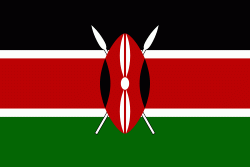Trans Mara District (Trans Mara District)
Trans Mara District was an administrative district in the former Rift Valley Province of Kenya. Its capital town was Kilgoris. The district had a population of 170,591 (1999 census) and an area of 2,846 km². It was created in 1994, when Trans Mara District was split from Narok District.
The Mara Triangle (part of the Masai Mara reserve) is located in Trans-Mara District. The district had only one local authority, Trans Mara county council. Kilgoris Constituency was the only constituency of the district.
Under the 2010 Constitution of Kenya and the new devolved form of government, the Trans Mara area was merged into Narok County. It continues as the Kilgoris Constituency electorally and administratively.
Its name refers to the territory "across the Mara River" from the perspective of the rest of Narok County. The term "Trans Mara" is still used to refer to the geographical area.
* Aridland.go.ke
* Reliefweb.int
The Mara Triangle (part of the Masai Mara reserve) is located in Trans-Mara District. The district had only one local authority, Trans Mara county council. Kilgoris Constituency was the only constituency of the district.
Under the 2010 Constitution of Kenya and the new devolved form of government, the Trans Mara area was merged into Narok County. It continues as the Kilgoris Constituency electorally and administratively.
Its name refers to the territory "across the Mara River" from the perspective of the rest of Narok County. The term "Trans Mara" is still used to refer to the geographical area.
* Aridland.go.ke
* Reliefweb.int
Map - Trans Mara District (Trans Mara District)
Map
Country - Kenya
 |
 |
| Flag of Kenya | |
Kenya's earliest inhabitants were hunter-gatherers, like the present-day Hadza people. According to archaeological dating of associated artifacts and skeletal material, Cushitic speakers first settled in Kenya's lowlands between 3,200 and 1,300 BC, a phase known as the Lowland Savanna Pastoral Neolithic. Nilotic-speaking pastoralists (ancestral to Kenya's Nilotic speakers) began migrating from present-day South Sudan into Kenya around 500 BC. Bantu people settled at the coast and the interior between 250 BC and 500 AD. European contact began in 1500 AD with the Portuguese Empire, and effective colonisation of Kenya began in the 19th century during the European exploration of the interior. Modern-day Kenya emerged from a protectorate established by the British Empire in 1895 and the subsequent Kenya Colony, which began in 1920. Numerous disputes between the UK and the colony led to the Mau Mau revolution, which began in 1952, and the declaration of independence in 1963. After independence, Kenya remained a member of the Commonwealth of Nations. The current constitution was adopted in 2010 and replaced the 1963 independence constitution.
Currency / Language
| ISO | Currency | Symbol | Significant figures |
|---|---|---|---|
| KES | Kenyan shilling | Sh | 2 |
| ISO | Language |
|---|---|
| EN | English language |
| SW | Swahili language |















